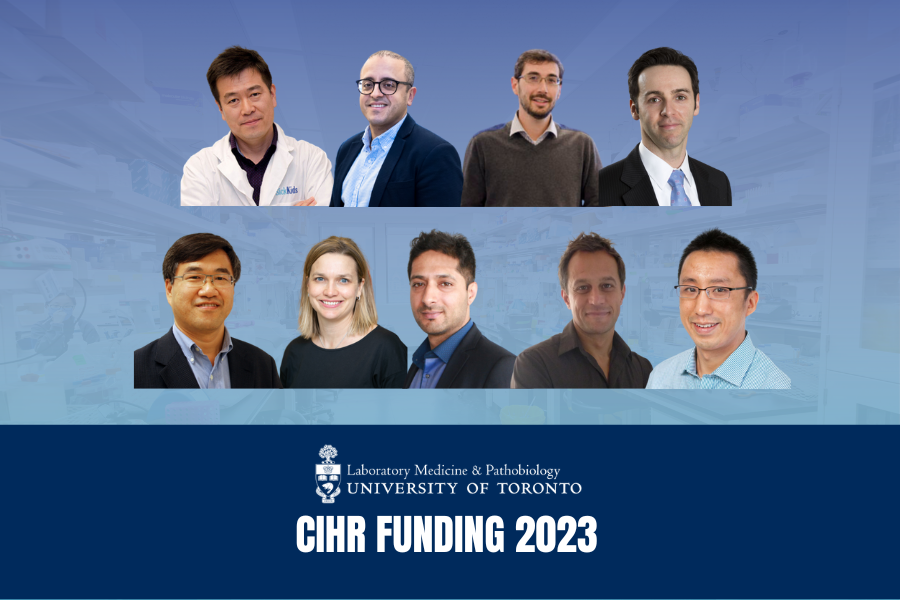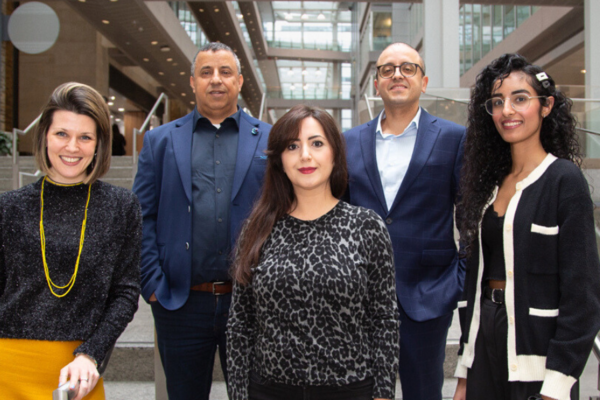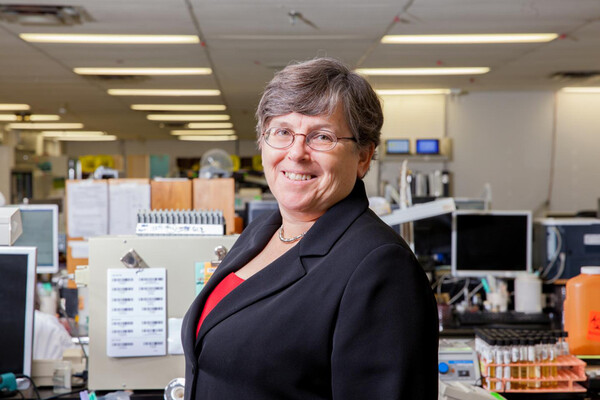From diagnosing bone and soft tissue cancer to peroxisomes: latest CIHR funding for LMP

We are delighted to announce that three of our primary LMP researchers, and six cross-appointed faculty were successful in receiving funding in the Canadian Institutes of Health Research (CIHR) spring 2023 competition.
These projects have the potential to help societies get healthier by advancing the understanding and diagnosis of disease in keeping with Department of Laboratory Medicine and Pathobiology’s vision.
Congratulations to all!
- Hoon Ki Sung (with collaborator Peter Kim): Peroxisome in Adipose Tissue Expansion
- Karim Mekhail: Studying nucleolar RNA polymerase II and its ncRNAs to restrain cancer
- Adam Shlien: Development of an RNA-based test for diagnosing and monitoring bone and soft tissue cancers
- Slava Epelman (Department of Medicine): Differential type I interferon responses drive sex-specific vulnerability to viral myocarditis
- Jennie Johnstone (Department of Medicine with collaborators Nick Daneman, Matthew Cheng, Tood Lee, Emily McDonald, Sean Ong and Steven Tong): Evaluating the impact of a SIMPlified LaYered consent process versus a conventional informed consent form on recruitment of potential participants to a large platform clinical trial: a pragmatic nested randomized controlled trial (SIMPLY-SNAP Trial)
- Mohit Kapoor (Department of Surgery): Contribution of synovial fibroblast cell subsets to the pathogenesis of knee osteoarthritis
- Ren-Ke Li (Department of Surgery): Rejuvenation of the Aged Bone Marrow Niche Restores Hematopoietic Stem Cell Function for Cardiac Repair and Regeneration
- Michael Reber (Department of Ophthalmology & Vision Sciences with collaborator Eric Bouffet): Effectiveness of a visual telerehabilitation program on visual perception in children with hemianopia consecutive to a brain tumour.
- Darren Yuen (Department of Medicine): YAP and TAZ: novel regulators of collapsing glomerulopathy
CIHR Project Grants
Peroxisome in Adipose Tissue Expansion
Dr. Hoon Ki Sung, Hospital for Sick Children (Collaborator: Dr. Peter Kim)
Project abstract: Fat cells in adipose tissues can absorb an almost limitless amount of fat that we eat. Storing fat in adipose tissue prevents fats from gathering in other tissues like blood vessels, the liver, and muscles, where it can do harm.
Accumulation of fat in these tissues is associated with diseases such as fatty liver, heart disease and diabetes. Therefore, there is a growing interest in understanding the biology of fat tissues.
Central to the function of fat cells in fat tissues is a specialized compartment or organelle called lipid droplets. When there is excess energy, the energy is converted to fat and stored in lipid droplets causing the lipid droplet and, thus, the fat cell to increase in size. However, in low energy conditions, the fat cells retrieve fats and release them to the body to be used for energy. How the fat cells store and release fats from lipid droplets is not well understood.
Our unpublished data found that peroxisomes, an organelle that makes and breaks down unique fats, aid in the growth of lipid droplets. This finding suggests a new way by which fat cells control lipid droplets. To address how peroxisomes aid in lipid droplet growth, our two laboratories, with expertise in fat biology and animal studies and expertise in peroxisome biology and advanced imaging, have established an interdisciplinary team that consists of collaborators from both national and international laboratories. Together, we are well positioned to bring about a new understanding of how fat cells form and maintain their lipid droplets using cellular and animal models coupled with advanced imaging and metabolic analysis techniques.
The knowledge gained from this study may provide new tools and information to develop therapies for diseases related to fat tissue dysfunction.
Studying nucleolar RNA polymerase II and its ncRNAs to restrain cancer
Dr. Karim Mekhail, University of Toronto
Project abstract: The human body is composed of trillions of cells, the longevity of which depends on the balance between forces that promote or stall growth. On the one hand, early cell stalling is known as senescence, and it can lead to premature cellular aging if kept unchecked. On the other hand, uncontrolled cell growth can lead to cancer.
Critical to the cell's ability to strike the right balance between growth and senescence are highly repetitive DNA regions known as ribosomal DNA (rDNA) repeats. These rDNA repeats harbor genes from which ribosomal RNA (rRNA) is produced. rRNA production is critical to cell growth. In contrast, DNA damage within rDNA repeats triggers premature senescence. So, the rDNA repeats are like a two-edged sword.
How cells strike the right balance between the impact of rDNA on growth and senescence is unclear. Here, we pursue new findings suggesting that a novel network of proteins localizes to poorly understood spacers within rDNA repeats to optimize protein production and growth while limiting DNA damage and cell senescence. This network includes the breast and ovarian cancer tumor suppressor BRCA1 and several proteins collectively termed RNX.
We have two main aims:
- First, we will study how this protein network allows cells to ensure the benefits while limiting the potentially harmful effects of the two-edged sword that is rDNA.
- Second, we will control this network to turn rDNA into a cancer-fighting weapon that we can use on-demand to block growth and increase senescence and death only in breast cancer cells.
So, this project will uncover critical health-related knowledge on the balance between cell growth and senescence while revealing how to exploit this information to combat deadly human diseases, thereby improving the health and extending the life of Canadians.
Development of an RNA-based test for diagnosing and monitoring bone and soft tissue cancers
Dr. Adam Shlien, Hospital for Sick Children
Project abstract: One in six deaths is due to cancer, which is typically diagnosed many years after disease initiation. Only a minority of tumour types can be found early using current screening technology.
We have developed a software tool that identifies the key, defining features of any tumor by studying their RNA. As described in our recent publication, this tool is over 90% accurate and has the potential to become a universal platform for all patients with cancer. In this project, we will further develop and implement this platform.
This will be done for patients with bone and soft tissue cancers, collectively called 'sarcoma', which are often misdiagnosed. Our results will improve the diagnostic accuracy and lead to a tool for surveillance of sarcoma patients. This work is being conducted by a group with direct experience implementing and validating clinical-grade tumor testing. These technologies are part of an existing patent family (three patent filings submitted by The Hospital for Sick Children), which will be exclusively licensed to our start-up company.
With a robust commercialization plan, validated technology and an experienced team in place, our start-up will address the massive need for improved care for sarcoma patients. We will begin with sarcoma to validate our approach, then broaden testing to other cancer types. Oncology as a whole, is a very large market - the direct U.S. medical costs for cancer in 2020 were an estimated $200.7 billion. Because many genes are over-expressed in cancer, tests based on detection of RNA have the potential for higher sensitivity even when the tumor mass is small. For these reasons, the global market for RNA based clinical diagnostic is forecasted to reach $2B by 2026.
Differential type I interferon responses drive sex-specific vulnerability to viral myocarditis
Dr. Slava Epelman, Department of Medicine
Project abstract: Viral myocarditis is an important contributor to the development of heart failure - a devastating diagnosis with a 5-year mortality rate of 74%. Importantly, there is compelling evidence that the clinical impact of viral myocarditis and viral-induced cardiomyopathy is underestimated. We also understand that young males are much susceptible to severe viral myocarditis, yet we do not understand how that occurs.
Our preliminary studies in mice have demonstrated that female mice produce very early anti-viral cytokines (type I interferons) that protect against cardiac injury, but males do not. This grant will explore the cell types and triggers involved in mediating this very early protective anti-viral pathway.
Evaluating the impact of a SIMPlified LaYered consent process versus a conventional informed consent form on recruitment of potential participants to a large platform clinical trial: a pragmatic nested randomized controlled trial (SIMPLY-SNAP Trial)
Dr. Jennie Johnstone, Department of Medicine
Project abstract: In this study, we plan to test out a new way to explain clinical trials to potential participants.
Obtaining patients' consent to participate in trials is difficult, as patients often find consent forms daunting with too much information. These forms are very long, and many patients do not read them. Even among those that do, they may not fully understand them. This can put off patients with different educational or cultural backgrounds, depriving them the chance to benefit from a clinical trial. Patients, when ill in the hospital, may also be unable to read long forms, which may cause more discomfort to them.
We will test out a new simplified consent process where the patient takes the lead in directing how much information they want to read. There will be a simplified form with the most important information needed to make a decision safely. For patients keen to know more, there are links to extra information and videos on a website. This is much simpler than the current forms used, which can be up to 20 pages and filled with complex information.
We will study patients invited to participate in a large clinical trial for blood infection, the SNAP trial, and compare this new method to the current long form by randomly allocating patients to either the new form or the current form. We will then look at how the different forms affects patients' willingness to participate in the trial, their overall satisfaction with the consent process, and their understanding of the trial.
We hope that this method will increase patient participation in trials and provide patients a more positive experience with research. If the results are positive, this approach can be extended to all future clinical trials.
Contribution of synovial fibroblast cell subsets to the pathogenesis of knee osteoarthritis
Dr. Mohit Kapoor, Department of Surgery
Project abstract: Osteoarthritis (OA) is a progressive, degenerative disease of the joints. Patients with OA experience pain, stiffness and loss of quality of life. There are no approved therapies to stop OA progression.
The knee is made of a number of tissues including cartilage, which cushions the joint, and the synovium, which covers the joint and produces a lubricating fluid for smooth joint movement. During OA, cartilage is lost and the synovium becomes scarred. Research to date has mostly focused on cartilage loss; however, the synovium has recently gained attention for its contributions to OA.
Using advanced sequencing techniques, combined with sophisticated informatics tools, we identified fibroblasts as the most abundant cell type within the synovium. In addition, we found that fibroblasts can be further separated into "subsets" by the individual genes they express, and by the disease stage from which patient tissues were obtained. We believe fibroblast subsets have distinct functions during different stages of OA and play crucial roles in mediating joint destruction during OA.
In this proposal, we aim to determine the roles of fibroblast subsets to OA disease progression. Using synovium from patients (females and males) with early or late stages of knee OA disease from our established large-scale tissue bank, and knee joints from an animal model of OA, we will use a combination of advanced sequencing, cell culture technique and histology to:
- Define fibroblast subsets and their localization in early vs late stages of knee OA,
- determine the contribution of fibroblast cell subsets to OA synovial pathologies, and
- identify the role of BHLHE40, a regulator of fibrosis-related genes, to OA pathology.
We anticipate uncovering specific cell subsets that contribute to OA disease process and determining the potential of BHLHE40 as a novel target for OA therapy.
Rejuvenation of the Aged Bone Marrow Niche Restores Hematopoietic Stem Cell Function for Cardiac Repair and Regeneration
Dr. Ren-Ke Li, Department of Surgery
Project abstract: Significant lifespan increases have occurred worldwide due to medical advances. However, this increased lifespan has not been met with similar quality of life improvements, owing to increased chronic disease prevalence among the elderly, such as the most common clinical issue of congestive heart failure after a heart attack, which also contributes to increased health care costs.
Stem cells play a critical role in maintaining heart function, and their functional deterioration is an aging hallmark. Understanding how stem cells age will unveil the mechanisms behind age-related heart tissue functional decline, along with facilitating the development of therapies to rejuvenate aged individuals and improve heart function.
The bone marrow (BM) is a stem cell reservoir, responsible for producing immune cells involved in tissue repair. BM stem cells reside in a specialized microenvironment, the BM niche, where interactions with surrounding cells help maintain stem cell function. It has been established that BM stem cell function declines with aging, but it is still mostly unknown how the specialized niche contributes to this process and how these changes affect heart function post-heart attack. We have previously shown that aged BM cell replacement with young cells restores heart repair responses.
In this application, we will determine how BM niche contributes to stem cell aging, and whether its rejuvenation can restore stem cell function and their heart repair capacity.
Our study will:
- understand how niche cells affect stem cell aging
- identify key molecules controlling cell:cell communication,
- determine whether BM niche cell rejuvenation will affect BM stem cell function, and
- determine whether BM niche cell rejuvenation affects BM stem cell capabilities for heart repair.
The results will identify novel approaches to restore cellular environments, as well as develop therapies able to effectively improve aged heart function and individuals' health.
Effectiveness of a visual telerehabilitation program on visual perception in children with hemianopia consecutive to a brain tumour
Dr. Michael Reber. Department of Ophthalmology & Vision Sciences
Project abstract: Brain tumour and their treatment in children are often associated with loss of vision. Depending on the type of brain tumour, thirty to ninety percent of the children have vision loss including decreased visual acuity and contrast sensitivity, loss of color vision, and visual field loss (hemianopia) profoundly impacting their learning, mobility, development, independence and quality of life. No visual rehabilitation procedures are currently existing for children with visual field loss consecutive to brain tumour.
Together with several studies, our preliminary results suggest that patients with hemianopia improve visual perception in the damaged visual field after an audiovisual stimulation procedure. Our promising visual telerehabilitation approach uses high-technology devices to provide audiovisual stimulation with better ecological validity due to virtual reality, greater flexibility due to home-based programs and improved efficiency due to patient-tailored protocols.
In this multicentric study, we seek to investigate the effectiveness of a 6-weeks audiovisual telerehabilitation program on visual perception in 40 children aged 10-17 years old with visual field loss consecutive to a brain tumour. Participants will be recruited in paediatric neuro-oncology programs in 5 Canadian centres. They will follow the audiovisual telerehabilitation program from home with remote control of the device from our laboratory. Visual assessments will be performed at their hospital ophthalmology clinic at baseline, 3 weeks and 6 weeks with follow-ups at 1 and 6 months.
Primary outcomes will be visual field restoration. Secondary outcomes will correspond to visual function, functional vision and quality of life. Exploratory outcomes will be head movement, eye-tracking and brain activity in primary visual area V1. We anticipate our procedure could increase overall visual perception ultimately improving mobility, development and quality of life.
YAP and TAZ: novel regulators of collapsing glomerulopathy
Dr. Darren Yuen, Department of Medicine
Project abstract: Collapsing glomerulopathy (CG) is an aggressive kidney disease that rapidly progresses to kidney failure. Although first recognized as a complication of uncontrolled HIV infection, doctors now know that CG can be triggered by other infections such as COVID-19, as well as by certain auto-immune diseases. Unfortunately, little is known about why and how CG occurs, and so no effective treatments exist.
What is known is that people of recent African descent have a much higher risk of developing CG, at least in part because of a higher chance of having mutations in a gene called APOL1.
Podocytes are specialized cells in the kidney that help filter blood to produce urine. In CG, podocytes proliferate in an uncontrolled manner, a process which is accompanied by rapid and extensive scarring of the kidney. How changes in APOL1 might cause these changes is not well understood. YAP and TAZ are two closely related proteins that promote cell proliferation and scarring. We have recently shown that the podocytes of people with APOL1 mutations and CG have hyperactive YAP and TAZ, as do the podocytes of mice which have the same APOL1 mutations seen in humans with CG.
In this proposal, we will examine how APOL1 mutations can lead to YAP and TAZ activation, and how YAP/TAZ activation causes CG. Ultimately, we anticipate that our findings may inform the development of new treatment strategies for this devastating disease.



